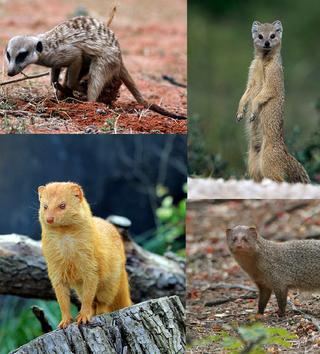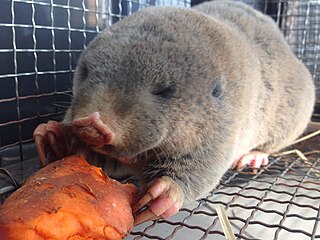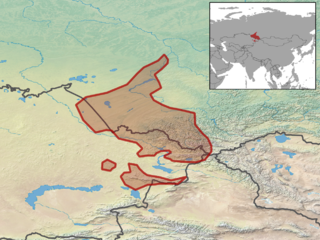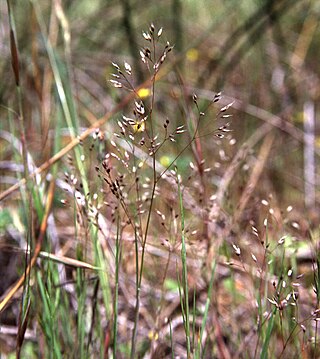
A mongoose is a small terrestrial carnivorous mammal belonging to the family Herpestidae. This family is currently split into two subfamilies, the Herpestinae and the Mungotinae. The Herpestinae comprises 23 living species that are native to southern Europe, Africa and Asia, whereas the Mungotinae comprises 11 species native to Africa. The Herpestidae originated about 21.8 ± 3.6 million years ago in the Early Miocene and genetically diverged into two main genetic lineages between 19.1 and 18.5 ± 3.5 million years ago.

Zokors are Asiatic burrowing rodents resembling mole-rats. They include two genera: Myospalax and Eospalax. Zokors are native to much of China, Kazakhstan, and Siberian Russia.

The Spalacidae, or spalacids, are a family of rodents in the large and complex superfamily Muroidea. They are native to eastern Asia, the Horn of Africa, the Middle East, and southeastern Europe. It includes the blind mole-rats, bamboo rats, mole-rats, and zokors. This family represents the oldest split in the muroid superfamily, and comprises animals adapted to a subterranean way of life. These rodents were thought to have evolved adaptations to living underground independently until recent genetic studies demonstrated they form a monophyletic group. Members of the Spalacidae are often placed in the family Muridae along with all other members of the Muroidea.

Myospalax is a genus of rodents in the family Spalacidae. It contains these species of zokor:

Batomys is a genus of rodent endemic to the Philippines. It has six extant described species.
Cerradomys subflavus, also known as the terraced rice rat or flavescent oryzomys, is a rodent species from South America in the genus Cerradomys. It is found in the states of Goiás, São Paulo, and Minas Gerais, Brazil. Populations in Bolivia, Paraguay, and elsewhere in Brazil that were previously placed in this species are now classified as various other species of Cerradomys.

Oecomys concolor, also known as the unicolored oecomys, unicolored rice rat, or unicolored arboreal rice rat, is a species of rodent in the genus Oecomys of family Cricetidae. It is found in tropical rainforest in the Amazon biome, but its range is poorly documented; it has been recorded in northwestern Brazil, southeastern Colombia, and southern Venezuela.
The white-tailed mountain vole is a species of vole in the family Cricetidae. It is found in India and Pakistan.
The large-eared vole is a species of rodent in the family Cricetidae. It is found in Mongolia and the Russian Federation.
The central Kashmir vole is a species of rodent in the family Cricetidae. It is found only in India and Pakistan.
The Alai mole vole is a species of rodent in the family Cricetidae. It is known only from Kyrgyzstan, where it has been found in temperate grassland in the Alai Mountains. Little else is known about the vole.

Melanomys caliginosus, also known as the dusky melanomys or dusky rice rat, is a species of rodent in the genus Melanomys of family Cricetidae. It is found from Central America, in Honduras, Nicaragua, Costa Rica, and Panama, into South America, where it occurs in Venezuela, Colombia, and Ecuador. Populations currently classified under M. caliginosus may in fact include more than one species.

The East European vole is a species of vole (rodent) in the family Cricetidae.

The Palawan soft-furred mountain rat is a species of rodent in the family Muridae. It is the only species in the genus Palawanomys. It is found only in Palawan, Philippines, and has been recorded on Mount Mantalingajan.
The Sulawesi giant rat is a species of rodent in the family Muridae. It is monotypic in the genus Paruromys. The species is endemic to Sulawesi in Indonesia, where it inhabits forests at elevations from sea level to the tree line. It is frugivorous and semiarboreal. While not currently listed as threatened, it is impacted by both habitat destruction and subsistence hunting.
The false zokor is a species of rodent in the family Spalacidae. It is found in Mongolia, China and Russia.

The Siberian zokor is a species of rodent in the family Spalacidae. It is found in Kazakhstan and Russia.
In biology, a species is the basic unit of classification and a taxonomic rank of an organism, as well as a unit of biodiversity. A species is often defined as the largest group of organisms in which any two individuals of the appropriate sexes or mating types can produce fertile offspring, typically by sexual reproduction. Other ways of defining species include their karyotype, DNA sequence, morphology, behaviour or ecological niche. In addition, paleontologists use the concept of the chronospecies since fossil reproduction cannot be examined.

The Poeae are the largest tribe of the grasses, with around 2,500 species in 121 genera. The tribe includes many lawn and pasture grasses.












